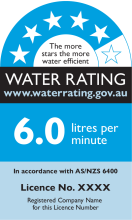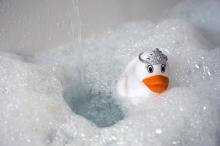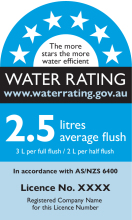
Shower
Modern 4-star water efficient showerheads use no more than 6 litres of water per minute whilst still providing great performance. Older style showerheads can use up to 20 litres per minute.
Some quick ways to use water efficiently in the shower
- Try to reduce the time you spend showering by using a shower timer. You can get sand timers and electronic timers. Alternatively just choose your favourite 4-minute song from this playlist.
- Shave your legs before taking a shower, then use the shower water to rinse off.
- Use a bucket to collect water while waiting for the shower to get hot. You can use this excess water to water your plants.
- Replace your showerhead with a 4 star rated WELS showerhead. These are designed with performance in mind to ensure you still enjoy a powerful shower that uses water and energy efficiently.
- Consider an instantaneous water heater if your existing water heater is located some distance to the bathroom. Talk to a plumber first to make sure it will work adequately with your showerhead.
- Make sure your hot water system thermostat is not set too high. Adding cold water to reduce the temperature of very hot water is wasteful.
Choose a top-rated showerhead
Before buying a new showerhead, check the manufacturer’s water efficiency labels. Australia’s Water Efficiency Labelling and Standards (WELS) scheme allows consumers to compare the water efficiency of different products using a star rating system. By buying more water efficient products you can save money on water and electricity bills and help the environment!
Learn how to change your showerhead!
Using water efficiently in the shower not only saves water, but uses less energy. So you’ll not only save money on both bills, but also reduce your impact on the environment.
It’s easy to change to a new shower head yourself. You’ll need a cloth, an adjustable spanner or multi tool, steel wool and Teflon tape; the tape usually comes with a new shower head.
Shower tips
- Take shorter showers – aim for less than four minutes. Limit time spent in the shower to soap up, wash down, and rinse off. Shorter showers also save on energy costs associated with heating water.
- Use a shower timer. Choose from a manual four-minute egg timer or a more sophisticated electronic timer that either attaches to the shower wall or showerhead or is wired into the wall during construction.
- Use a bucket to collect water while waiting for the shower to get hot.
- Shave your legs before taking a shower. Use running shower water to rinse off.
- Consider an instantaneous water heater if your existing water heater is located some distance to the bathroom. Talk to a plumber first to make sure it will work adequately with your showerhead.
- Make sure your hot water system thermostat is not set too high. Adding cold water to reduce the temperature of very hot water is wasteful.
Bath
Many people believe that baths waste a lot of water. However, often a bath may use less water than showering. Follow these tips to ensure that you are using the bath water wisely!
- Adding cold water to cool very hot water is a waste of energy and water. So, make sure your hot water system thermostat is not set too high - ideally no higher than 60°C
- Only fill the tub with as much water as needed.
You can use your bath water on your garden too!
Use a bucket to throw bath water onto the garden or wash your car with it!
Check that soaps and detergents in the water won’t harm garden plants.
Toilet
1/4 of all the water we use in the bathroom is flushed down the toilet!
- Old toilets can use up to 18 litres per flush, so put a water filled plastic bottle or a brick into your cistern to reduce the water used
- Leaking toilet cisterns waste litres of water each day. Check for leaks by putting a few drops of food dye in the cistern. If you have a leak, coloured water will appear in the bowl before the toilet has been flushed.
- Toilet leaks are often a result of the rubber valve in the cistern deteriorating. You can contact a licensed plumber to fix this for you.
- Don’t use your toilet as a bin. Feminine hygiene products, food waste, baby wipes and goldfish should go in the bin! Flushing these down the toilet not only wastes valuable water but places additional strain on the sewerage system.
Renovating soon?
If you are building a new home or doing a bathroom renovation consider installing plumbing to flush your toilets using rainwater or greywater.
Buy a dual flush toilet with a four-star water efficiency rating. These toilets use just 4.5 litres for a full flush and 3 litres for a half flush.
Follow these simple steps to check if your toilet has a leak!
- Remove the lid of your toilet cistern.
- Place a few drops of food dye into the cistern.
- Do not flush your toilet for 10-15 minutes.
- If the dye has seeped down into the bowl when you return, then you know you have a leak.
Choose a top rated toilet
Before buying a new toilet, check the manufacturer’s water efficiency labels. Australia’s Water Efficiency Labelling and Standards (WELS) scheme allows consumers to compare the water efficiency of different products using a star rating system. By buying more water efficient products you can save money on water and electricity bills and help the environment!




